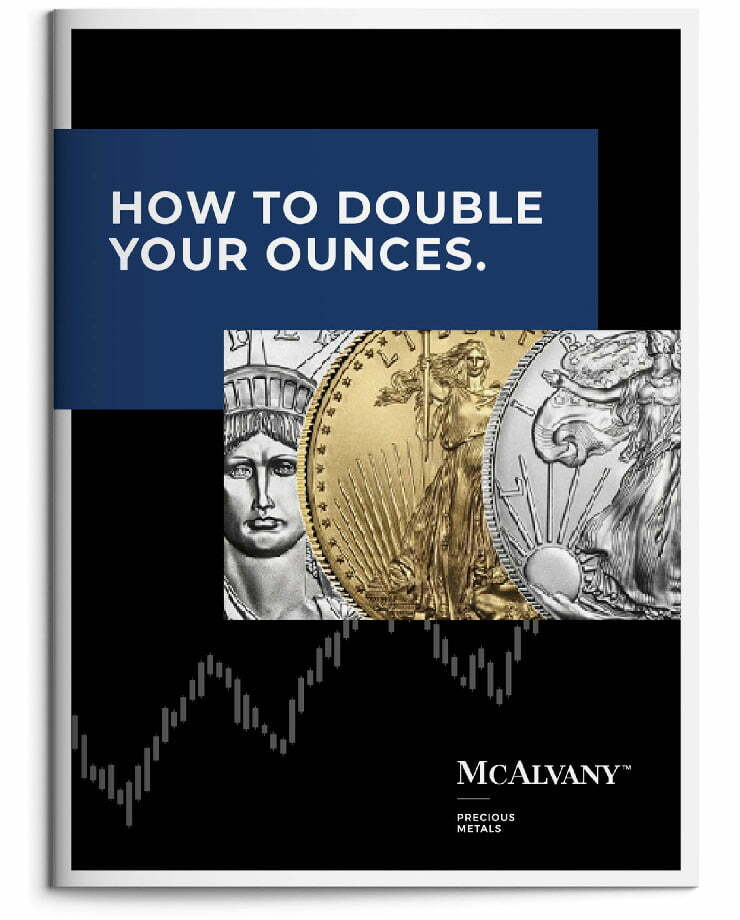Podcast: Play in new window
- Big Beautiful Spending Bill Will Spend More Than Ever
- 50% Tariffs On EV… Just Joking?
- US Dollar Down In Gold – 29% In One Year – 48% In Five Years
“The bond market is a mess. The US long bond reached levels last week we haven’t seen since July of 2007. The Japanese long bond, at 3.19, reached a record high for an instrument that’s only existed since 1999. The UK long bond on Wednesday hit its high since just prior to the blow-up of Long-Term Capital Management in 1998. Now the British people are dealing with a broader contextual issue, high levels of debt, inflation percolating even higher, and bond investors feeling inadequately compensated for the inflation which is creeping back into the picture. Yields going higher will not end well for your leveraged speculators, will not end well for your equity investors, will not end well for your investor with a high risk appetite.” —David McAlvany
* * *
Kevin: Welcome to the McAlvany Weekly Commentary. I’m Kevin Orrick, along with David McAlvany.
David, Saturday night was really, really special. A guy that I had worked with here with your family for over 30 years, he is now retired, and they came into town because they were riding the bike race, and you graciously invited us all over so that we could just experience that family time again. I know I said, “Well, what can I bring? I said, Debbie and I have gotten a few recent bottles of Caymus wine.” And you said, “Oh, well that’ll be good. That’ll be good. I’ve got something too that I might be able to share with you.” And I’ll let you tell the audience what you served. I brought 2022 Caymus wine, red wine, and—
David: And 1992 to match.
Kevin: Why did you pick ’92?
David: It was the year that our company moved down from Denver to Durango, and both you and Larry were a part of that move. 12 or 13 families made the trek, but it was a super busy weekend. I can’t remember the last time we had social events planned four nights in a row.
Kevin: It was very, very special. I’ll tell you what, that 1992, not all wines lay down well, but this was a Caymus that was signed by the guy who owned the vineyard.
David: Chuck Wagner.
Kevin: Yeah, yeah.
David: The opportunity to reconnect with a friend that worked with us from 1980 to I think almost 2022. It was amazing. Lots of memories refreshed that night. Last night was different, Memorial Day with a military man, West Point graduating class of 1967.
Kevin: Wow, ’67.
David: We talked about how his class had one of the highest casualty rates of any West Point class in the school’s history. Upon graduation getting shipped out to Vietnam, he lost dozens of his classmates, sharp guy. It brought home how dear a price we pay for our military engagements, how costly freedom is.
Saturday morning, sort of preceding that. I was on the back porch with my son discussing Just War Theory. He had questions about when it’s right to kill a person or engage in conflict, and so I probably bored him to tears with Aristotle and Cicero and Augustine, but to me it’s an important conversation as my son considers a career in the military. I think it’s poignant.
I think my dad was the last person in our family to serve, and so, 16, he’s involved in Civil Air Patrol, setting his sights on the corps of cadets at Texas A&M when he finishes high school, and he’s motivated like I’ve never seen him.
Kevin: Oh, I know. My wife was saying the same thing. She said, “Wow, he is really, really laser-focused.” And that’s fine. Yeah, your dad was in the Air Force. So thanks to all the guys who have served this country. Memorial Day is an important day, but let’s go to the market volatility because most news outlets right now just want to blame the uncertainty from Trump tariffs, but is that it?
David: There is a temptation to see market volatility through the lens of the twists and turns of Trump’s tariffs. Certainly it exists. Last week it was 50% tariffs on the EU. This week, a stay of execution after a lengthy conversation with Ursula von der Leyen on Sunday. The clearer picture emerges when you focus and bring your scope a little broader.
You’ve got currency trends, you’ve got bond yields which tell their own story, and they predate Trump by many years. So unsettling volatility is what you get from the on/off dynamics of tariffs. But the bigger picture is too important to ignore, which is not to say that Truth Social posts are inconsequential, just that they serve as a lightning rod in a storm, and the storm has been building for a long time. Ultimately it is and will continue to be felt in the currency markets and the bond markets. And so something as simple as deficit-to-GDP of 6.7%—the highest outside of war, outside of recession—that’s a real-time gamble on growth this administration is putting in motion, but I think one thing for sure, fiscal conservatism is missing in action.
Kevin: Well, and that’s something that— It’s easy to get distracted and say, well, DOGE is just cleaning up a lot of things and they are cleaning up a lot of things, but we’re actually talking about spending more money than we have been, not less.
David: Last week, a spending bill passed the house. It increases and already bloated 1.5 to $2 trillion annual deficit by at least 231 billion more per year. That’s the Congressional budget Office’s estimate. 231 billion more per year over a ten-year period, 2.31 over the decade. And there are other estimates as high as 380 billion more per year for a decade.
It’s fair to say that the bond market has bigger concerns than Truth Social posts—again, this is the storm which predates Trump. Neither is Trump, nor is the House—we’ll see what the Senate does—battening down the hatches. They’re more or less putting out the sails.
We want to stay sanguine and assume that we don’t have a recession over the next 10 years. Probably not a realistic assumption, but in that 10-year period, getting to 2.3 trillion in fresh spending, deficit spending added to our existing stock of debt, it’s a bit of an issue. It’s a bit of an issue.
And if we got a recession, we would certainly add another two, four, six, eight trillion to the debt. You were sitting here contemplating deficit-to-GDP figures at 6.7, and those are high figures, but throw in a recession and you’re in the teens or low twenties. And frankly that’s what we see in the bond market. The bond market is less sanguine by the day.
Kevin: Well, Scott Bessent of the Treasury, though, would say, we are really going to try to grow the economy faster than the compounding of debt. Is that something that can happen, do you think, with what they’re proposing?
David: Time will tell. If you can grow the economy faster than compounding debt— I mean basically he’s getting back to that statistic of deficit-to-GDP, and it was debt-to-GDP, slightly different figure, which was on the minds of the folks at the Congressional budget office over 15 years ago, and the estimates were that they would need in order to pay back the debt—maybe this is no longer even a consideration, kind of a silly consideration, who needs to do that?—but if you’re going to actually pay back the debt, you need double-digit economic growth each year for the next 50 years. Kind of a tall order. So I think they’re changing focus to just that deficit, the annual run rate of the deficit to GDP. And if you can get it closer to 3%, they’ll consider that sustainable.
Kevin: Morgan just shared with us that the 1965 to 1985 period of high inflation, we actually did have high GDP above 6.6%. The idea of actually trying to raise the GDP or grow the GDP faster than the debt usually is an inflationary policy, isn’t it?
David: Well, that’s right. I mean, there is a question of if Bessent will succeed. He’s the champion of trying to design a system that is pro-growth. We’re not against it, but it may come with a price, a consequence, and I did not like his comments last week, unconcerned about the US fiscal position. To me, it borders on the absurd, but if you are going to increase GDP considerably, you probably are tempting fates with inflation, and that leaves the Fed in a very, very trapped position.
Kevin: Last week, we had a lot of conflicting types of things. You’ve got the passage of the Big Beautiful Bill by the house, but you also had the Moody’s downgrade.
David: That’s right. Both headlines. And I might suggest we have unique domestic bond market concerns bubbling up, and that’s not entirely the case. Global yields have been on the rise for years.
Global yields have been on the rise for years, and in the last three to six months are letting you know that there is just too many IOUs in the global system.
Kevin: So it’s not just the United States?
David: Not just in the US. The US 10-year Treasury has come from the lows of 50 basis points in terms of yield to a current 4.46, recently touched 4.6% last week. UK yields, just as another example, have risen from negative territory to 4.66%, flirting with higher levels than we witnessed with Liz Truss jamming in new unfunded spending initiatives with inflation raging in the background and causing a crisis of confidence. And just, if you would let that sink in, UK yields have in recent days passed the Liz Truss panic levels with very little market fanfare.
Kevin: Wow.
David: Then you have the EU, likewise trading at less than zero yields, and now an aggregate of at least 10 European yields over 2.56%. Last but not least, or seemingly least, is the Japanese government bonds moving higher and to disturbing levels given the government’s pre-commitment to carrying so much debt.
Kevin: So we know that the longer-dated the bond is, the more it’s affected by interest rates rising or falling. I mean, what does that look like for the Japanese?
David: Long-dated Japanese bonds are getting crushed. The consequence of such moves— You can see it from two different vantage points. It’s positive on the one hand, negative on the other. For insurance companies and pension funds, the higher rates, they make or fully fund your liabilities in the future, so higher rates are attractive from that standpoint. But from a balance sheet perspective, if you must account for asset values on a mark-to-market basis, you’re dead. Nippon Life Insurance, the largest Japanese life insurer, is an example. Again, they don’t have to report these things on a mark-to-market basis, but you can at least see the kind of hole that gets blown in the balance sheet from a rise in rates.
Very similar to Silicon Valley Bank a few years ago, buying Japanese government bonds for years, Nippon Life Insurance has been stacking up its unrealized losses. Their losses have tripled in the last year. They’re now sitting at 25 billion US dollars, 3.6 trillion yen, that’s as of March, and rates have gone even higher in April and May, which means even more acute Japanese government bond losses. So again, we get to play games here. Mark-to-model, mark-to-make believe, those are the required accounting tools when these bond yields march higher. And we’ll get to a couple of comments from US Bank CEOs in a moment, but their concern about the debt markets is very much tied to a rise in interest rates and what that does to their Treasury holdings in their fixed income positions on their own balance sheets.
Kevin: It reminds me, there are times when I have to reach over and touch a piece of fake fruit because I’m not quite sure if it’s real or if it’s fake. They can make that thing look very, very real. And when you’re talking about mark-to-model or mark -to-make-believe, it’s like the fruit is sitting on the table, but it’s not real fruit. It’s hollow. And if that bill ever gets called in, they’re going to find out that it’s not real.
David: Looks good, not very edible.
Kevin: But you can’t blame Trump for this, right? I mean, we’re talking Japan right now has been doing this for 30 some odd years, they’ve been building toward this.
David: Well, that’s why I wanted to expand the scope of the conversation because while there is volatility in the US bond market, it’s not just the US bond market. It wasn’t Trump causing a stir in Japan last week. It was Japan’s prime minister saying that his country’s financial situation is worse than that of Greece. Debt-to-GDP over 260%, with an aging population driving up pension and healthcare costs, shrinking birth rates—and that’s much lower projected tax revenue in the future. Again, this is all of the fiscal picture for Japan. Now you have an increase in rates which makes debt payments unsustainable. His comments left a chill in the Japanese bond market.
And in the US, even at last night’s dinner with the gentleman from West Point, if Japan can get away with such high debt levels relative to GDP, why can’t we? I heard it last night. I hear it from so many investors. Well, I would say, if you undervalue your currency for three decades and artificially suppress interest rates for three decades and maintain a de facto debt monetization scheme for 20 to 30 years, you, too, can pretend to be in a healthy and viable fiscal position. Yet, healthy is not the best description of the Japanese, the UK, or the US fiscal position.
Kevin: So how do they do it, though? Because isn’t the Bank of Japan prohibited from monetizing their own debt?
David: They are, but there’s always workarounds. So while the Bank of Japan can’t monetize debt, it uses the large Japanese banks to book as what are described as temporary holdings the equivalent of 40% of all outstanding Japanese debt. So again, I use the word temporary very loosely.
Kevin: Guaranteed buyers, basically.
David: Yeah, the Bank of Japan routinely buys up to 70% of new issued debt. That keeps a lid on interest rates, and as long as you keep a lid on interest rates you can continue to spend more than you bring in. So running deficits is not a big deal as long as you control rates.
Just like the delusional Modern Monetary Theory crowd on this side of the pond, the game works till it doesn’t. And the Bank of Japan is losing control of rates and therefore losing control of its fiscal destiny. Does that sound familiar?
Kevin: Right.
David: The UK is losing control of rates, and therefore losing control of its fiscal destiny. And the US is losing control of rates, and therefore losing control of its fiscal destiny. The bond vigilantes are noticing.
Kevin: How about gold?
David: As is the gold market. So the Modern Monetary Theory playbook looks like a borrowed page from the last 30 years of Japanese financial engineering, which is crumbling in the present tense. But it worked for a while, so maybe we should all accept expediency as a workable strategy. And we certainly see policymakers embracing, again, embracing fiscal and monetary pragmatism. That is what the Big Beautiful Bill feels like. Light on fiscal restraint, light on cuts—spending cuts, that is. Where does that lead us? Ultimately, it leads us in the direction of monetization. Ultimately, it points us towards yield curve control, towards devaluing fiat in an effort to cover over fiscal pragmatism.
Kevin: So to quote Winston Churchill again, the further you can look back, the more you can look forward. If you look hundreds of years backwards, you see an interest rate cycle where interest rates will rise for about 30 years and then fall for about 30 years. We went through about a 40-year period—you and I did, Dave, our adult lives—of a falling interest rate paradigm that got them to negative a few years ago, and then it reversed. So all this debate, let’s think about it. There are people who take hundred-year bond bets. I don’t know why they would do that, especially in the face of a rising interest rate market. But you remember the 100-year bond?
David: Oh, yeah. We had Bloomberg’s John Authers last week highlighting the Austrian century bond, issued at par in 2017, traded to a high of 158 in 2019, due to the—
Kevin: Because of negative rates, right?
David: Yeah, the insanity of negative rates. Hit 75.2 in January of this year, and is currently languishing at a price of 61.27.
Kevin: So it went from 158 down to 61.27?
David: But from 100 to 158 and then to 61, so all that drama most recently from the increase in Austrian yields from 75 basis points to 3%. And the price spike coincided with deeply negative rates, and of course now we have a depression in price as rates are returning to higher levels. Speculators were betting that a little negative, in terms of the rates, would become a lot more so. Policymakers were loving free money. The 0.85s—and that is the annual rate of return, the 85 basis point return of the 2120s—they’re interesting. 85 basis points is supposed to accommodate inflation risk over the next 100 years.
Kevin: That makes no sense.
David: Surely not. So the debt storm is a global phenomenon. Austrian century bonds are merely symptomatic, and they’re not going to change the system. At a mere $6.5 billion in IOUs, they are almost immaterial, but the losses accruing to the fixed income community as rates increase are the opposite, and the vigilantes are pricing in some of what they see as material risk globally.
Kevin: Is this why the auctions are starting to become very, very nail-biting?
David: Exactly. Last week there were two disappointing bond auctions, the US 20-year bond auction, 16 billion in debt, which was undersubscribed and impacted the entire yield curve. It took the 10-year over 4.6. It took the 30-year over 5%. And a Japanese auction was the second disappointment, also underwhelming with the same net result, higher rates, and you could see it across the board. Japanese 40-year bonds were priced to yield 3.7%, and that means that they’ve moved a full percentage point since early April. And if you want to do the math, that translates to between a 20 and 30% loss in a matter of weeks.
Kevin: What it sounds like you’re saying, Dave, is we’re seeing yields on bonds right now that only occur when there’s a panic, but right now, they’re just quietly rising to a level that we haven’t seen in a long time.
David: They’re quietly rising, and there are a few people taking note. And the few people who are taking note, we should give them a little bit of sun, a little bit of time in the limelight. We just want to summarize. The bond market is a mess, and I want to add some notable quotes, but the US long bond reached levels last week we haven’t seen since July of 2007.
Kevin: Wow.
David: The Japanese long bond, at 3.19, reached a record high for an instrument that’s only existed since 1999. The UK long bond on Wednesday hit its high since just prior to the blow-up of Long-Term Capital Management in 1998. Liz Truss had her moment, but now the British people are dealing with a broader contextual issue: high levels of debt, inflation percolating even higher, and bond investors feeling inadequately compensated for the inflation which is creeping back into the picture. Yields going higher will not end well for your leveraged speculators, will not end well for your equity investors, will not end well for your investor with a high risk appetite.
Kevin: But there are so many people who crave those yields because they need a steady income. And so wouldn’t you see a large influx of money going in as these yields get to these high levels?
David: Typically that’s the case, and I think that’s one of the noteworthy things that’s happened in recent weeks. When bond yields are on the rise, there is often an influx of capital to take advantage of higher yields. We talked about pension funds, insurance companies, and meeting their future liabilities with higher yields. That is normal behavior. It is therefore quite significant when you get rising yields and falling currency values, basically evidence of traffic exiting a currency instead of flowing in for yield. So last week in the US, you had equities trading lower. The dollar traded lower. Bond prices, lower—yields up. None of which is healthy when combined.
Kevin: So often, we talk about gold being a safe haven investment when you see these types of things happening. But recently, a lot of people have said, “Well, cryptocurrency is the new gold.” Do you see bitcoin as being a safe haven?
David: I think we’ve had evidence since the beginning of the year that it’s anything but a safe haven, and it tends to operate as a risk asset in league and in line with other risk assets. So, John Authers also noted the move higher in bitcoin up 40% since the tariff pause on April 8th. Just let that sink in, 40% since the tariff pause. It was under pressure prior to, and now the pressure is off. It’s at 14% year-to-date, and he says it’s now plain that the cryptocurrency is not regarded as a safe haven.
Kevin: Hmm.
David: Bitcoin’s price accelerated only once a semblance of calm returned. That’s a fair point. It trades like a risk asset. Gold’s year-to-date performance of 26% tells a different story, more risk-off. If you’ve got risk off, you have safe-haven seeking. Gold has done very well in that context. If you relieve the tariff pressure, reintroduce risk-on in the broader markets, what does gold do? It corrects. So, risk-off emerges again, capital flows towards the shiny metal, and we see the shiny metal’s best days still ahead of us. That’s what we think.
Kevin: You bring up the bond vigilantes often, and oftentimes people will go, “Well, who are those people?” But there are some big names that have come out. You read some quotes here at the meeting this morning, starting with Citigroup CEO Jane Fraser. Would you read the quotes from not only her but Dalio?
David: Yeah. I mean, I think one of the things you have to keep in mind is that a bank’s assets are interest-rate sensitive. You make loans, and that’s an asset for the bank. And they also have securities portfolios, which is just buying another form of debt. So, you’ve got debt of two different varieties, and both are very interest-rate sensitive. So, I think that’s one of the things that’s getting to Dimon’s perspective and Fraser’s perspective is we see shifts happening, and it has a direct impact on our balance sheet.
The Citigroup CEO Jane Fraser characterized the current environment well. She says, “We’re entering a new phase of globalization, one less defined by cooperation, more by strategic self-interest. Long-held assumptions are being challenged, not just by tariff announcements but by a deeper confidence shock. The near-term impact is already being felt, and the long-term trajectory is being rewritten in real time. If you’re looking to markets for clarity, you might be a tad disappointed, but if you’re looking for signals, they’re everywhere.”
Kevin, the first thing she mentions as a signal is Treasury yields. She says, “Treasury yields rose even as equity markets wobbled. The US dollar, typically a safe haven, has weakened at moments when it used to rally. That tells us something deeper is going on. Investors aren’t just pricing near-term risks. They’re reevaluating the credibility of long-held certainties. It’s showing up in how capital moves. Pensions and asset managers are tilting more towards Japan, India, and parts of Europe. Hedge funds are being selective and did not chase the April equity bounce. Sovereign wealth funds are diversifying more aggressively. Hedging against the dollar is now at levels we haven’t seen in years.”
Kevin: It’s interesting that she used the term signals because you interviewed Pippa Malmgren. Remember that? She wrote the book Signals, and the idea is, start looking around at things that you normally wouldn’t look at, and this is what we’re seeing here.
David: Among those long-held certainties, something quite basic, confidence in our fiscal and monetary policymakers, confidence in the legislators that choose to ignore the debt storm brewing. So, we have confidence decreasing, but I don’t think confidence is yet at its lowest ebb.
Kevin: So, this takes us to Dalio’s quote because he talked about just downgrading the ratings of the credit institutions.
David: This is in response to last week’s Moody’s downgrade. So, “You should know,” he says, “that credit ratings understate credit risks because they only rate the risk of the government not paying its debt. They don’t include the greater risk that the countries in debt will print money to pay their debts, thus causing holders of the bonds to suffer losses from the decreased value of the money they’re getting rather than from the decreased quantity of money they’re getting.” Said differently, for those who care about the value of their money, the risks for US government debt are greater than the rating agencies are conveying.
Kevin: Hmm. He’s saying they’re understating it.
David: And here I think the bond vigilantes get it. Higher rates, higher gold, both of those are an expression of vigilante concerns over sustainability and the wisdom of putting out your sails as the stormy gales pick up speed. Shrinking back debt and deficits would bring a sense of calm to the vigilantes, to the fixed-income investors who are asking the Dalio question. The risk of countries in debt printing money to pay it off is on the increase.
Kevin: One of the things that was always strange to us, at least for over a decade, was the power of central banks, their ability just with words to work all the problems out of the market. “We’ll do whatever it takes in 2011,” and actually it worked for a while, but Jamie Dimon, this last quote, says that— I think he’s disappointed that central banks don’t really have the control they think they do.
David: He says, “We have huge deficits. We have what I consider complacent central banks, almost so complacent that central banks think they’re omnipotent.”
Kevin: Hmm.
David: “And you all think they can manage through all this. I don’t think they can manage all that. They set short rates. They don’t set the 10-year rate. Who sets 10-year rates? You do. Foreigners own 35 trillion of US public securities as debt. Corporate credit, money, market funds, US debt, they’re there to help set that rate. And I look at all the things, including trade, trade in general, not just tariffs, it’s creating a lot of risk out there and you should be prepared for it.”
Kevin: So, Dave, we’ve talked about safe havens. If you are preparing for risk, what does it look like? Where do you go?
David: Again, I just think it’s interesting that Dalio, Fraser, and Dimon all have an issue with the debt markets—complacency within the debt markets and what they see as a tougher road ahead. What does it mean for Dimon to be prepared for it? I’d love to have that conversation with him. What does it look like? The retail investor chasing the April equity bounce is not preparing for a risk environment. They’re ignoring the bond market. They’re ignoring the currency markets.
And from those two markets a registration of concern, a real true signal, and instead of deciding that they should double down. Again, not a surprise to see bitcoin hit all-time highs in the context of risk-on, categorical risk-on that is what that asset represents.
Kevin: And so, yeah, that happened after there was a calm with the pause on tariffs, which shows— Let’s go back to the oldest money on earth. Okay. The oldest money on earth, really the most consistent money, is gold. Priced in gold—you remember the guy you met back in the Bahamas who said, “You just need to price everything in gold.” Talk about signals. Your best signal is just to price things in gold, honestly.
David: Yeah. And I think this is where, if you’ve not been to his website, I would encourage you to, pricedingold.com. It’s a fascinating look at an upside-down world, or better put, he right-sides everything. And to see things through the lens of gold is to come up with a slightly different narrative, but it’s a helpful perspective in this respect.
So, how would you prepare for risk? One of the ways that you might do that is moving to cash. But what is the value of cash, and what currency are you denominated in? Is it dollars? Is it Canadian dollars? Is it euros? Is it Japanese yen? Is it rupees? Is it renminbi?
I think it’s very interesting. He had a little chart on his most recent missive where he shows the US dollar performance in gold terms. Again, US dollar performance—
Kevin: Priced In gold.
David: —in gold terms. One year performance of the US dollar ,down 29.5%. Five-year performance, down 48%. The Canadian dollar, one year performance, down 30%. Five-year performance, down 47.5%. The euro, in gold terms, down 26.2% over the last 12 months. Over the last five years, 46% loss. Japanese yen, a mere 23% loss in the last 12 months. Catastrophic 61% loss in gold terms over the last five years. In the RMB, 27.9 down over the last 12 months, and minus 49 over the last five years. And again, it’s one thing to see gold on the ascendancy. It’s another to see fiat on the descendancy. And I think there’s a very healthy perspective there, priced in gold.
Kevin: So, for the person who says, “Well, I’m getting 4.5% at my bank, or 5% at my bank.” If you’re not getting 29.5% that’s how much the dollar has lost in gold.
David: To be clear, I think cash makes a lot of sense today if you want to de-risk a portfolio. But to adequately de-risk your cash position from the inflationary effects of central bank policy and the inevitability of dealing with a debt problem that we simply can’t afford to go the other way. You can either inflate it away or you can default on it. And if you default on it, you destroy the insurance industry, you destroy the banking industry, you destroy pension funds. There are riots and revolutions if the US government or your G-7 countries default on their debt.
Kevin: But if you quietly inflate the debt away?
David: That’s right.
Kevin: Yeah.
David: So, on a shorter-term time frame, one week, three weeks, three months, six months, cash is king. Cash is king because it’s the anti-volatility play. But to look at cash on a longer-term basis, three months, six months, two years, if you’re not adequately protecting the downside— And the downside is currency volatility. The downside is that you are subject to financial repression. A part of the tool set that our policymakers have to alleviate the vast quantities of debt that are no longer sustainable.
To sidestep that and avoid the compression, you have to have a metals portfolio. I mean, are we self-interested in saying so? Yes, we are. Is there another alternative? Well, if you want to look at bitcoin, you can. And perhaps have miscategorized bitcoin as a risk asset, but it does seem to move in light of monetary supply growth. It does seem to move along with other risk assets. It does seem to have the same turbocharged stimulus that you have with semiconductors and the QQQs.
So, if you’re thinking of de-risking, if you’re thinking of hedging, I don’t see it. If you’re thinking about diversifying into other risk assets, by all means be my guest.
Kevin: But cash and gold is what you’re saying, right?
David: And frankly, if I were going to take risk, putting capital at risk, it would not be in bitcoin. Yes. It’s had a 14% year-to-date return. Gold miners are up 44% year-to-date. Where is my preference in terms of economic fundamentals, viability, free cash flow, dividend yields? I think I know where I’ve already planted my flag and where I would tend to going forward.
So, preparing for risk, what does it look like? It’s something very different than what we see the market practitioner doing today. And I think it’s in keeping with Dimon’s reflections, with Dalio’s reflections, with Fraser’s reflections. We have deficits. We have complacent central banks. We have a credit system which is underestimating the amount of risk in that credit system. We are in a new phase of globalization. It is far less cooperative.
There is very clearly on display on a global basis strategic self-interest. And no, we can’t hold the same long-held assumptions. They’ve been challenged. And if you’re not paying attention, there is a lot at stake.
* * *
You’ve been listening to the McAlvany Weekly Commentary. I’m Kevin Orrick, along with David McAlvany. You can find us at mcalvany.com and you can call us at (800) 525-9556.
This has been the McAlvany Weekly Commentary. The views expressed should not be considered to be a solicitation or a recommendation for your investment portfolio. You should consult a professional financial advisor to assess your suitability for risk and investment. Join us again next week for a new edition of the McAlvany Weekly Commentary.
















